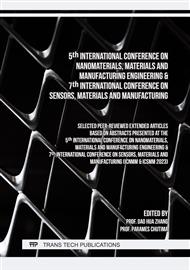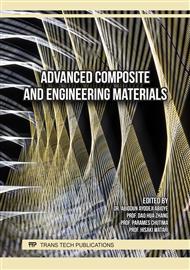p.43
p.49
p.55
p.63
p.73
p.81
p.91
p.101
p.107
Comparative Examination of Cellulose Nanosphere from Corn Husk and Rice Straw
Abstract:
Cellulose nanosphere (CNS) is a novel material isolated through delignification, bleaching, acid hydrolysis, dialysis, and sonication of cellulose fibers from agricultural wastes such as corn husk and rice straw. Comparative examination through multiple characterizations of CNS from these cellulose sources was conducted to investigate its potential applications. Corn husk cellulose nanospheres (CHCNS) and rice straw cellulose nanospheres (RSCNS) were characterized by its chemical characteristics, crystallinity, surface morphology and thermal stability. FTIR showed the same transmittance patterns for both CNS samples. The peaks for CHCNS and RSCNS in the NMR analysis were comparable, and the presence of toluene enabled the CNS dissolve better in DMSO-d6. Higher crystallinity index was calculated in CHCNS than in RSCNS according to XRD analysis. TEM analysis demonstrated that CHCNS has shorter diameter than RSCNS. Lower onset degradation temperature relative to their corresponding bleached cellulose fiber was determined through TG Analysis. Biomedical applications such as drug delivery, wound dressings and tissue engineering are the most suitable applications based on the profiles of both CNS samples.
Info:
Periodical:
Pages:
73-80
Citation:
Online since:
February 2024
Authors:
Keywords:
Price:
Сopyright:
© 2024 Trans Tech Publications Ltd. All Rights Reserved
Share:
Citation:



